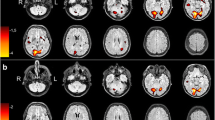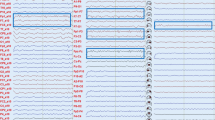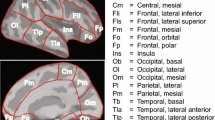Abstract
Purpose
Previously, a joint ictal/inter-ictal SPECT reconstruction was proposed to reconstruct a differential image representing the change of brain SPECT image from an inter-ictal to an ictal study. The so-called joint method yielded better performance for epileptic foci localization than the conventional subtraction method. In this study, we evaluated the performance of different reconstruction settings of the joint reconstruction of ictal/inter-ictal SPECT data, which creates a differential image showing the difference between ictal and inter-ictal images, in lesion detection and localization in epilepsy imaging.
Methods
Differential images reconstructed from phantom data using the joint and the subtraction methods were compared based on lesion detection performance (channelized Hotelling observer signal-to-noise ratio (SNRCHO) averaged across four lesion-to-background contrast levels) at the optimal iteration. The joint-initial method which was the joint method that was initialized by the subtraction method at optimal iteration was also used to reconstruct differential images. These three methods with respective optimal iteration and the subtraction method with four iterations were applied to epileptic patient datasets. A human observer lesion localization study was performed based on localization receiver operating characteristic (LROC) analysis.
Results
From the phantom study, at their respective optimal iteration, the joint method yielded an improvement in lesion detection performance over the subtraction method of 26%, which increased to 145% when using the joint-initial method. From the patient study, the joint-initial method yielded the highest area under the LROC curve as compared with those of the joint and the subtraction methods with optimal iteration and with 4 iterations (0.44 vs 0.41, 0.39 and 0.36, respectively).
Conclusions
In lesion detection and localization, the joint method at optimal iteration outperformed the subtraction method at optimal iteration and at iteration typically used in clinical practice. Furthermore, initialization by the subtraction method improved the performance of the joint method.







Similar content being viewed by others
References
Fisher RS, van Emde BW, Blume W, Elger C, Genton P, Lee P, et al. Seizures and epilepsy: definitions proposed by the International League Against Epilepsy (ILAE) and the International Bureau for Epilepsy (IBE). Epilepsia. 2005;46:470–2.
Picot MC, Baldy-Moulinier M, Daurès JP, Dujols P, Crespel A. The prevalence of epilepsy and pharmacoresistant epilepsy in adults: a population-based study in a Western European country. Epilepsia. 2008;49:1230–8.
Wiebe S, Blume WT, Girvin JP, Eliasziw M. A randomized, controlled trial of surgery for temporal-lobe epilepsy. N Engl J Med. 2001;345:311–8.
Paesschen WV. Ictal SPECT. Epilepsia. 2004;45:35–40.
Spanaki MV, Spencer SS, Corsi M, MacMullan J, Seibyl J, Zubal IG. Sensitivity and specificity of quantitative difference SPECT analysis in seizure localization. J Nucl Med. 1999;40:730–6.
Duncan JS. Imaging in the surgical treatment of epilepsy. Nat Rev Neurol. 2010;6:537–50.
Duncan JS, Winston GP, Koepp MJ, Ourselin S. Brain imaging in the assessment for epilepsy surgery. Lancet Neurol. 2016;15:420–33.
Lee HW, Hong SB, Tae WS. Opposite ictal perfusion patterns of subtracted SPECT: hyperperfusion and hypoperfusion. Brain. 2000;123:2150–9.
Zubal IG, Spencer SS, Imam K, Seibyl J, Smith EO, Wisniewski G, et al. Difference images calculated from ictal and interictal technetium-99m-HMPAO SPECT scans of epilepsy. J Nucl Med. 1995;36:684–9.
O’Brien TJ, So EL, Mullan BP, Hauser MF, Brinkmann BH, Bohnen NI, et al. Subtraction ictal SPECT co-registered to MRI improves clinical usefulness of SPECT in localizing the surgical seizure focus. Neurology. 1998;50:445–54.
Rakvongthai Y, Fahey F, Borvorntanajanya K, Tepmongkol S, Vutrapongwatana U, Zukotynski K, et al. Joint reconstruction of ictal/inter-ictal SPECT data for improved epileptic foci localization. Med Phys. 2017;44:1437–48.
Cherry SR, Sorenson JA, Phelps ME. Physics in Nuclear Medicine. 4th ed. Philadelphia: Saunders; 2012.
Lai X, Petibon Y, El Fakhri G, Ouyang J. Joint reconstruction of rest/stress myocardial perfusion SPECT. Phys Med Biol. 2018;63:135019.
Penny W, Friston K, Ashburner J, Kiebel S, Nichols T. Statistical Parametric Mapping: The Analysis of Functional Brain Images. London: Elsevier; 2006.
Gifford HC, King MA, de Vries DJ, Soares EJ. Channelized Hotelling and human observer correlation for lesion detection in hepatic SPECT imaging. J Nucl Med. 2000;41:514–21.
Abbey CK, Barrett HH. Human-and model-observer performance in ramp-spectrum noise: effect of regularization and object variability. J Opt Soc Am A Opt Image Sci Vis. 2001;18:473–88.
Gifford HC, Kinahan PE, Lartizien C. King MA Evaluation of multiclass model observers in PET LROC studies. IEEE Trans Nucl Sci. 2007;54:116–23.
Schaefferkoetter J, Ouyang J, Rakvongthai Y, Nappi C. El Fakhri G Effect of time-of-flight and point spread function modeling on detectability of myocardial defects in PET. Med Phys. 2014;41:062502.
Bordonne M, Chawki MB, Marie PY, Zaragori T, Roch V, Grignon R, et al. High-quality brain perfusion SPECT images may be achieved with a high-speed recording using 360° CZT camera. EJNMMI Phys. 2020;7:65.
Swensson R. Unified measurement of observer performance in detecting and localizing target objects on images. Med Phys. 1996;23:1709–25.
Zeng GL. Maximum-likelihood expectation-maximization algorithm versus windowed filtered backprojection algorithm: a case study. J Nucl Med Technol. 2018;46:129–32.
Pareto D, Pavía J, Falcón C, Juvells I, Cot A, Ros D. Characterisation of fan-beam collimators. Euro J Nucl Med. 2001;28:144–9.
Tan KM, Britton JW, Buchhalter JR, Worrell GA, Lagerlund TD, Shin C, et al. Influence of subtraction ictal SPECT on surgical management in focal epilepsy of indeterminate localization: a prospective study. Epilepsy Res. 2008;82:190–3.
von Oertzen TJ, Mormann F, Urbach H, Reichmann K, Koenig R, Clusmann H, et al. Prospective use of subtraction ictal SPECT coregistered to MRI (SISCOM) in pre-surgical evaluation of epilepsy. Epilepsia. 2011;52:2239–44.
Acknowledgements
This work was supported by the Research Grant for New Scholar Ratchadaphiseksomphot Endowment Fund Chulalongkorn University. Jaruwan Onwanna was supported by the 100th Anniversary Chulalongkorn University Fund for Doctoral Scholarship, and by the 90th Anniversary Chulalongkorn University Fund (Ratchadaphiseksomphot Endowment Fund). The authors would also like to thank Katherine Zukotynski, MD, PhD for assembling patient data. The authors declare that there is no conflict of interest in conducting this research.
Author information
Authors and Affiliations
Corresponding author
Additional information
Publisher's Note
Springer Nature remains neutral with regard to jurisdictional claims in published maps and institutional affiliations.
Rights and permissions
About this article
Cite this article
Onwanna, J., Chantadisai, M., Tepmongkol, S. et al. Impact of reconstruction parameters on lesion detection and localization in joint ictal/inter-ictal SPECT reconstruction. Ann Nucl Med 36, 24–32 (2022). https://doi.org/10.1007/s12149-021-01680-x
Received:
Accepted:
Published:
Issue Date:
DOI: https://doi.org/10.1007/s12149-021-01680-x




